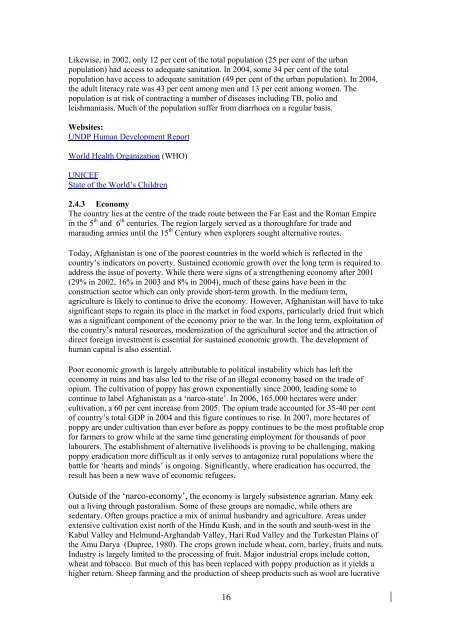Afghanistan. - Forced Migration Online
Afghanistan. - Forced Migration Online
Afghanistan. - Forced Migration Online
You also want an ePaper? Increase the reach of your titles
YUMPU automatically turns print PDFs into web optimized ePapers that Google loves.
Likewise, in 2002, only 12 per cent of the total population (25 per cent of the urban<br />
population) had access to adequate sanitation. In 2004, some 34 per cent of the total<br />
population have access to adequate sanitation (49 per cent of the urban population). In 2004,<br />
the adult literacy rate was 43 per cent among men and 13 per cent among women. The<br />
population is at risk of contracting a number of diseases including TB, polio and<br />
leishmaniasis. Much of the population suffer from diarrhoea on a regular basis.<br />
Websites:<br />
UNDP Human Development Report<br />
World Health Organization (WHO)<br />
UNICEF<br />
State of the World’s Children<br />
2.4.3 Economy<br />
The country lies at the centre of the trade route between the Far East and the Roman Empire<br />
in the 5 th and 6 th centuries. The region largely served as a thoroughfare for trade and<br />
marauding armies until the 15 th Century when explorers sought alternative routes.<br />
Today, <strong>Afghanistan</strong> is one of the poorest countries in the world which is reflected in the<br />
country’s indicators on poverty. Sustained economic growth over the long term is required to<br />
address the issue of poverty. While there were signs of a strengthening economy after 2001<br />
(29% in 2002, 16% in 2003 and 8% in 2004), much of these gains have been in the<br />
construction sector which can only provide short-term growth. In the medium term,<br />
agriculture is likely to continue to drive the economy. However, <strong>Afghanistan</strong> will have to take<br />
significant steps to regain its place in the market in food exports, particularly dried fruit which<br />
was a significant component of the economy prior to the war. In the long term, exploitation of<br />
the country’s natural resources, modernization of the agricultural sector and the attraction of<br />
direct foreign investment is essential for sustained economic growth. The development of<br />
human capital is also essential.<br />
Poor economic growth is largely attributable to political instability which has left the<br />
economy in ruins and has also led to the rise of an illegal economy based on the trade of<br />
opium. The cultivation of poppy has grown exponentially since 2000, leading some to<br />
continue to label <strong>Afghanistan</strong> as a ‘narco-state’. In 2006, 165,000 hectares were under<br />
cultivation, a 60 per cent increase from 2005. The opium trade accounted for 35-40 per cent<br />
of country’s total GDP in 2004 and this figure continues to rise. In 2007, more hectares of<br />
poppy are under cultivation than ever before as poppy continues to be the most profitable crop<br />
for farmers to grow while at the same time generating employment for thousands of poor<br />
labourers. The establishment of alternative livelihoods is proving to be challenging, making<br />
poppy eradication more difficult as it only serves to antagonize rural populations where the<br />
battle for ‘hearts and minds’ is ongoing. Significantly, where eradication has occurred, the<br />
result has been a new wave of economic refugees.<br />
Outside of the ‘narco-economy’, the economy is largely subsistence agrarian. Many eek<br />
out a living through pastoralism. Some of these groups are nomadic, while others are<br />
sedentary. Often groups practice a mix of animal husbandry and agriculture. Areas under<br />
extensive cultivation exist north of the Hindu Kush, and in the south and south-west in the<br />
Kabul Valley and Helmund-Arghandab Valley, Hari Rud Valley and the Turkestan Plains of<br />
the Amu Darya (Dupree, 1980). The crops grown include wheat, corn, barley, fruits and nuts.<br />
Industry is largely limited to the processing of fruit. Major industrial crops include cotton,<br />
wheat and tobacco. But much of this has been replaced with poppy production as it yields a<br />
higher return. Sheep farming and the production of sheep products such as wool are lucrative<br />
16
















